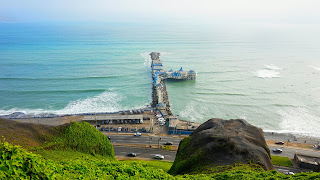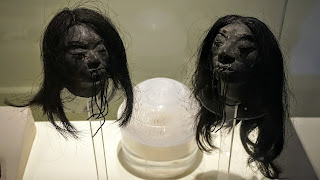We had a horrible start at Lima. Sleeping
in a bus is never as comfortable and relaxing than sleeping in a bed. Therefore,
we are a bit irritated in de morning sometimes. When we couldn’t find a cheap
Hotel and the one I booked was overbooked, we were very angry. We finally found
a very good, clean and cheap Hotel, but the area was horrible. Dirty, loud and
way too much away from everything. But, sometimes you can’t have everything and
you need to make a compromise. We were so mad, we’d like to leave ‘ugly Lima’
the next day, and just go to the Museum Michael wanted to see. But I’m very
glad we were just tired and hungry and changed our minds, because Lima is very,
very beautiful and there are a lot of things to do!
The transportation in Lima is amazing. You can choose
between Taxi, Minibus, normal Bus and Metro Bus. We choosed the Metro, because
they got their own lane on the street and therefore they are really fast, while
the other one stand in traffic jams. So we took the Metro and went to the
historic centre of Lima. There we visited the Museum and the Catacombs of the
San Francisco de Asis Church. Discovered in 1943, they contain thousands of
skulls and bones. The Catacombs has served as a burial-place until 1808, when
the city cemetery was opened outside Lima. It is estimated that 25,000 bodies
were laid to rest there. After the Church we strolled along the souvenir shops
and my lovely husband bought a beautiful handbag with typical Peruvian fabric
for me. Then we went to the Plaza del Armas (the main square) and looked at the
Catedral de Lima. After the lunchbreak we took the Metro to get down to Huaca
Pucllana, another Moche site in the middle of Lima. The pyramid is also made
with clay bricks, but they look a bit different than the Huacas at Trujillo,
because of another kind of clay. With the public bus, we went down to the
Parque del Amor, to get some nice photos of the ocean, the cliff and the city.
We walked everything up to the Kennedy park, which usually is full of straying cats.
But today was an open-air art exhibition and a big flower market so the cats
didn’t want to be in the crowded park. To make this day even more spectacular
we went to the Parque de la Reserva and enjoyed the colourful fountains in the
sunset and the lightshow at night. That was truly a magical and romantic
moment.
In the next morning, we went to the bus terminal to
buy a ticket for our trip to Ica. This time it was only a short distance, so we
will travel in the following morning. After we had our tickets we went to the
Nacional Museum of archaeologic, anthropologic and history of Peru. We saw a
lot of pottery and textiles, but the interesting things were the mummies and
the long skulls. Artificial cranial deformation or head flattening is a form of
body alteration in which the skull of a human being is deformed intentionally. Typically,
it is carried out on an infant, as the skull is most pliable at this time. In a
typical case, headbinding begins approximately a month after birth and
continues for about six months. The most famous aboriginals for this practice
were the Paracas. A lot of skulls had big round holes in the bone, which
sometimes were already healing, because the bone grew back and almost closed
the holes. It’s called head trepanation and this practice was realized by many
ancient cultures of the world and in Peru especially by the Paracas. This
surgery has been practiced by the ancient healers using different techniques
(scraping, drilling, cutting etc.) tools (stone, knives, spoons etc.) and
herbal beverages like Coca or Chicha as painkillers. The reason for this
practice was to eliminate pain caused by bone fracture that was made during
battle or, in other cases, as religious beliefs by trying to get rid of evil
spirits that were causing malfunction of the body. Displaying vast anatomical
knowledge, surgeons were able to perform without injure important vessels. They
were also skilled enough to operate at the inside of a skull. In some cases,
gold sheets were used for replacing missing pieces of skull. That was a very instructive day.
Wir hatten
einen furchtbaren Start in Lima. In einem Bus zu schlafen ist niemals so bequem
und entspannend wie im Bett. Darum sind wir manchmal etwas zickig am Morgen.
Als wir dann kein günstiges Hotel finden konnten und das, das ich gebucht habe
überbucht war, waren wir ziemlich angepisst. Wir fanden dann endlich ein sehr
gutes, sauberes und günstiges Hotel, aber die Lage war furchtbar. Dreckig, laut
und viel zu weit weg von allem. Aber manchmal kann man halt nicht alles haben
und man muss einen Kompromiss machen. Wir waren so verärgert, wir wollten
bereits am nächsten Tag das ‘hässliche Lima’ wieder verlassen und nur das
Museum anschauen, das Michi sehen will. Aber ich bin sehr froh, dass wir nur
müde und hungrig waren und unsere Einstellung zu Lima noch änderten. Denn Lima
ist sehr, sehr schön und es gibt sehr vieles zu Unternehmen.
Die Transportmöglichkeiten
in Lima sind der Wahnsinn. Man kann zwischen Taxi, Minibus, normaler Bus und
Metrobus wählen. Wir entschieden uns für die Metro, weil die eine eigene
Fahrbahn hatten und darum sehr schnell waren, während die anderen im Stau
stehen. So nahmen wir also die Metro und fuhren zum Historischen Zentrum von
Lima. Dort schauten wir uns das Museum und die Katakomben der San Francisco
Asis Kirche an. Entdeckt wurden sie im Jahre 1943 und beinhalten tausende
Schädel und Knochen. Die Katakomben dienten bis 1808 als Gräber, bis ausserhalb
Limas der erste Friedhof eröffnet wurde. Man nimmt an, dass etwa 25'000 Menschen
hier beerdigt wurden. Nach der Kirche flanierten wir den Souvenirshops entlang
und mein lieber Ehemann kaufte mir eine wunderschöne Handtasche mit typisch
peruanischem Stoff. Dann gingen wir zum Plaza del Armas (der Hauptplatz) und
schauten uns die Catedral del Lima an. Nach der Mittagspause gingen wir mit der
Metro runter zum Huaca Pucllana, eine weitere Moche Stätte inmitten von Lima. Die
Pyramide wurde auch aus Tonbacksteinen erstellt, jedoch sieht sie etwas anders
aus als die Huacas in Trujillo, weil es hier eine andere Art von Ton gibt. Mit
dem Bus ging es dann runter zum Parque del Amor um einige schöne Fotos vom
Ozean, dem Kliff und der Stadt zu machen. Wir liefen alles hoch zum
Kennedypark, welcher normalerweise voller streunender Katzen ist. Jedoch war
heute eine frei Luft Kunstausstellung und ein grosser Blumenmarkt, weshalb die
Katzen nicht im überfüllten Park sein wollten. Um diesen Tag noch spektakulärer
zu machen, gingen wir in den Parque de la Reserva und genossen die farbigen
Springbrünnen im Sonnenuntergang und die Lichtshow in der Nacht. Das war
wirklich ein magischer und romantischer Moment.
Am nächsten
Morgen gingen wir zum Busterminal um uns Tickets für unsere Reise nach Ica zu
besorgen. Diesmal ist es nur eine kurze Strecke, weshalb wir am nächsten Morgen
reisen werden. Nachdem wir unsere Tickets hatten, gingen wir zum Nationalmuseum
der Archäologie, Anthropologie und Geschichte von Peru. Wir sahen viele
Töpfereien und Textilien, aber die interessanten Dinge waren die Mumien und die
Langschädel. Künstliche Schädeldeformierung oder das Hauptflachdrücken sind
eine Form der Körpermodifizierung, in der der Schädel eines Menschen
absichtlich deformiert wird. Üblicherweise wird es bei Säuglingen ausgeführt,
weil der Schädel in dieser Zeit am meisten biegsam ist. In einem typischen Fall
beginnt das Hauptflachdrücken ungefähr einen Monat nach der Geburt und geht für
etwa sechs Monate so weiter. Das bekannteste Urvolk für diese Praktik waren die
Paracas. Viele Schädel
hatten große runde Löcher im Knochen, die manchmal bereits heilten, da der
Knochen zurück gewachsen ist und die Löcher fast wieder geschlossen hat. Diese
Praktik wird Haupttrepanation genannt und wurde durch viele alte Kulturen der Welt
ausgeübt, in Peru besonders von den Paracas. Diese Operation ist von den alten
Heilern ausgeübt worden, die verschiedene Techniken (kratzen, bohren, schneiden
etc.), Werkzeuge (Steine, Messer, Löffel etc.) und Kräutergetränke wie Coca
oder Chicha als schmerzstillende Mittel verwendeten. Der Grund für diese
Anwendung war, Schmerzen zu beseitigen, die durch Knochenbrüche während des
Kampfs verursacht wurden oder, in anderen Fällen, als religiöser Glaube, indem
man versuchte, Dämonen loszuwerden, die Funktionsstörung des Körpers verursachten.
Die Chirurgen waren im Stande gewesen dies auszuführen, ohne dass wichtige Gefäße
verletzt wurden, was von grossen anatomischen Kenntnissen zeugt. Sie waren auch
erfahren genug, um auf der Innenseite eines Schädels zu operieren. In einigen
Fällen wurden Goldplatten verwendet, um fehlende Stücke des Schädels zu
ersetzen. Das war ein sehr lehrreicher Tag.


































Keine Kommentare:
Kommentar veröffentlichen